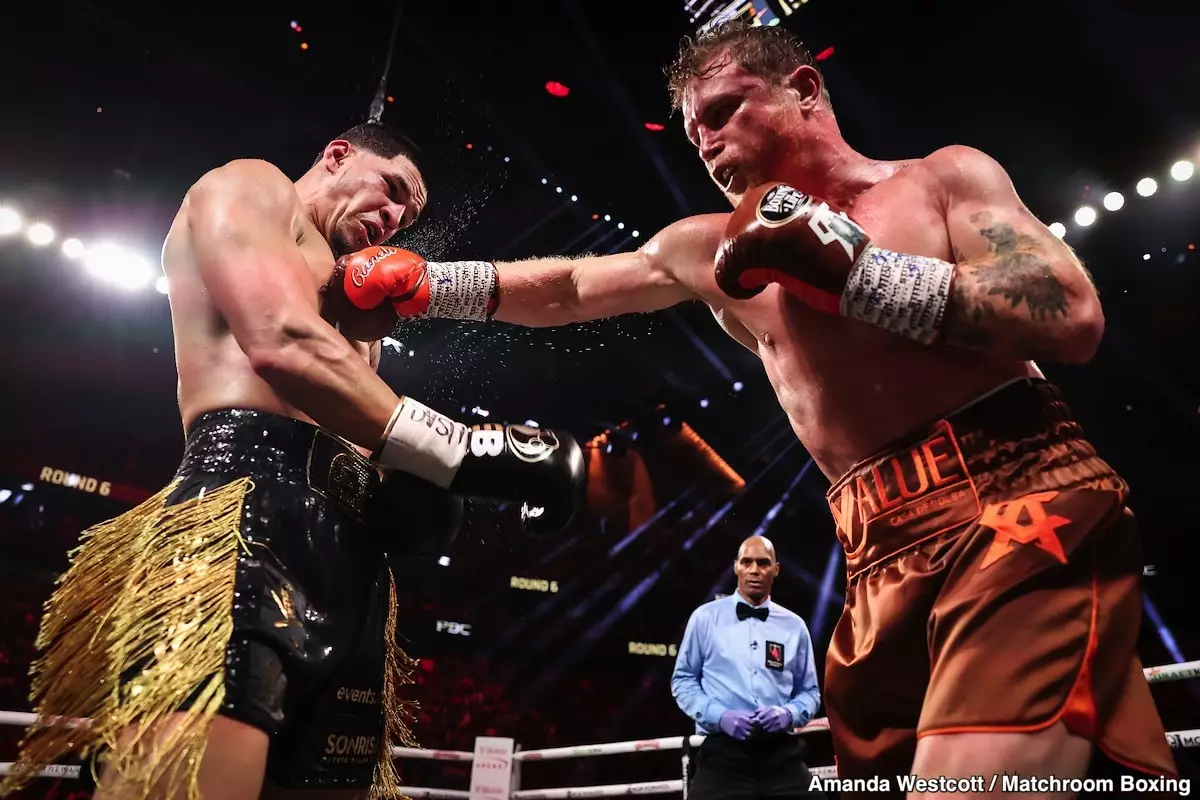BY BOXING HIT STAFF-
The boxing world is no stranger to drama, both inside and outside the ring. The latest chapter in this ongoing saga unfolded over the weekend with the highly anticipated clash between Canelo Alvarez and Edgar Berlanga. In a twist that could have rivaled any plot seen in a fight movie, Oscar De La Hoya, a former promoter of Canelo, boldly declared he wouldn’t tune in. Instead, he opted for Dana White’s UFC event, predicting that the boxing match would be a “lame ass fight.” However, the evolution of the event contradicted De La Hoya’s expectations, revealing much about Canelo’s enduring prowess and Berlanga’s tenacity.
As the rounds progressed, what De La Hoya deemed unworthy of financial investment proved to be an enthralling spectacle. Canelo’s performance showcased skill and agility that refuted any claims of deterioration typically associated with an athlete pushing into their mid-thirties. Although the match did not culminate with a knockout—a scenario that many anticipated—it was far from the lackluster affair De La Hoya had forecasted. Canelo’s arsenal of jabs, hooks, and counters delivered a narrative of resilience and tactical brilliance, culminating in a unanimous decision victory.
Edgar Berlanga entered the ring with a reputation for his explosive power and aggressive approach. Yet, it was his ability to withstand the flurry of punches from Canelo that spoke volumes about his potential as a contender in the boxing arena. Berlanga’s performance was characterized by remarkable composure and a fighting spirit that kept fans on the edge of their seats. He may not have emerged victorious, but he firmly established himself as a legitimate force, dispelling doubts regarding his capacity to compete at the highest level.
In the wake of the event, reactions ensued. Oscar De La Hoya took to social media, not with praise but rather critique, dismissing the fight as a snore-fest. His insistence that viewers “should have saved their hard-earned money” instead of investing in what he termed a lackluster show paints a picture of a promoter grappling with rival sentiments. The passive-aggressive undertones of his comments—accompanied by sleeping emojis—hint at more than mere disagreement; they suggest an underlying bitterness about his estranged relationship with Canelo.
Such public rebukes from De La Hoya seem to stem from a personal vendetta rather than a reasoned critique of the fight itself. His comments might resonate with some boxing fans who expected a different kind of show, but they do little to acknowledge Canelo’s undeniable qualities displayed in the ring. For a man of De La Hoya’s experience, it is rather striking to observe him fail to extend credit where it is due. Instead of evaluating the fight professionally, he withered into cynicism, unraveling any elegance he previously maintained in the public eye.
Now, what’s next for Canelo Alvarez? The boxing community is rife with speculation, considering potential matchups with Dmitry Bivol or Terence Crawford, each carrying their unique challenges. Canelo’s victory has reinvigorated conversations about his standing in the lineup of elite boxers, raising the question of whether he can sustain this momentum as he navigates complex adversaries. Canelo remains a figure of interest not just for his skills but also for the business aspect surrounding his fights. His marketability ensures his place in boxing discussions, dominating headlines well after the final bell.
The Canelo vs. Berlanga match unfolded far differently than Oscar De La Hoya anticipated. What could have been a moment for unity and celebration in the boxing community became overshadowed by De La Hoya’s disdain. Fans are left contemplating the inherent drama that combines athletic prowess and personal rivalry, building the anticipation of potential future showdowns that now seem inevitable. Boxing is undoubtedly alive and thriving, proving once again that there is always intrigue—and sometimes, controversy—that keeps audiences coming back for more.


Leave a Reply